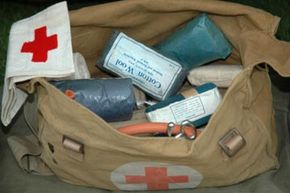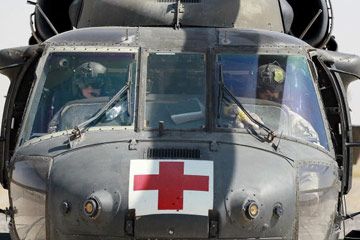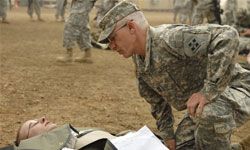While the media focus on "smart bombs" and remote-controlled drones, the ravages of war are still a harrowing reality for U.S. Army soldiers. In Afghanistan, Iraq and other global hot spots, frontline soldiers face life-threatening injuries. But until the turn of the century, soldiers were barely equipped to deal with their wounds.
"While we have made tremendous advances in modern medicine, we have not figured out how to keep people from being killed in combat," wrote retired Lt. Col. Donald Parsons in a 2004 issue of Infantry magazine.
Advertisement
Roughly 90 percent of soldiers killed in ground combat die before reaching medical facilities. Parsons, who served 30 years as an Army Special Forces medic and physician's assistant, and now works in the Army's Department of Combat Medic Training, says many deaths can be prevented through improved training and first aid gear.
The three leading causes of preventable battlefield death are blood loss from extremity wounds, collapsed lungs and obstructed airways. The Army's Improved First Aid Kit, or IFAK, is designed to address those immediate needs.
Developed since the Sept. 11, 2001, terrorist attacks, IFAKs are issued to every combat soldier. More streamlined than a full Army medic kit, the individual IFAK is a lightweight collection of supplies designed to limit many combat injuries that can often be applied by the injured solider.
"What soldiers used to carry was just a pressure dressing," said Major Kenneth Koyle, deputy chief of the Army Medical Department's Center of History and Heritage at Fort Sam Houston, Texas. "So if you got shot, you had one course of action, and that was to tie a bandage around it. That was the case up until shortly after 9/11. Then the IFAK came out. The kits have definitely evolved."
Today's Army IFAK weighs less than a pound (0.45 kilogram) and features a one-handed tourniquet (enabling self-application), a nasopharyngeal airway tube, elastic emergency trauma bandages (or "Israeli pressure dressing"), hemostatic combat gauze, adhesive tape and surgical gloves. All items are contained in a compact, folding kit that slides into a water-repellent pouch.
The Army IFAK shouldn't be confused with similarly named first aid kits from other branches of the armed services. The Marine IFAK is much more comprehensive, with a larger array of adhesive and compression bandages, burn dressing, iodine solution, antibiotic ointment, water-purification tablets and "quikclot" packets.
There's also the Army's Combat Lifesaver Aid Bag. What's in it? Keep reading.
Advertisement


